Family : Elephantidae

Text © Dr. Gianni Olivo

English translation by Mario Beltramini
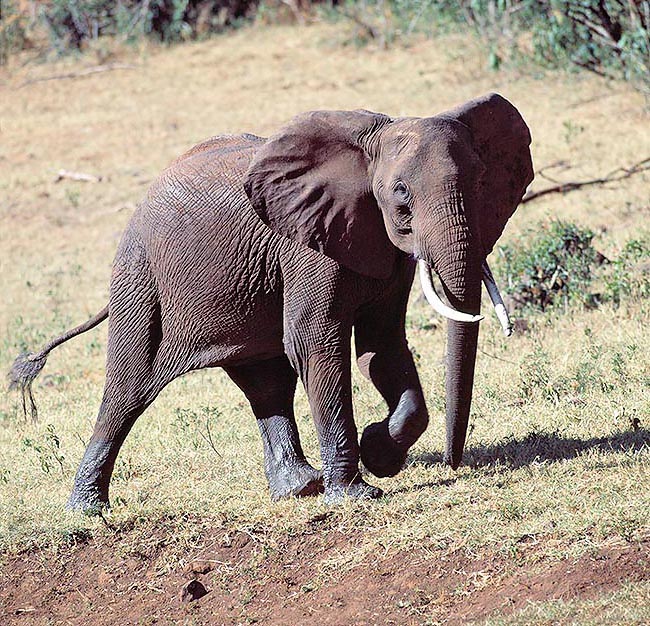
It’s sure that the African elephant is a species to protect, but how and at what cost? © Giuseppe Mazza
The progenitor of the species of elephants nowadays extant seems to have been a rather small animal with a structure similar to the suidae and without trunk but with two short tusks, tall only 60 cm at the withers, whose fossilized remains were found in Egypt.
The Moeritherium (this is the Latin name given) lived in the swamps and the wetlands bordering the Tethys Sea, in the Eocene, 50 million of years ago, sea that at the time was covering part of North Africa, when the present Sahara Desert was a patchwork of swamps and water meadows.
An accredited hypothesis is that the ancestor of the Moeritherium was a mammal, not yet well identified, from which descended on one hand, the Proboscidea, on the other, the Hyracoidea (hyraces), animals which, strange enough, even if resembling superficially to the marmots, are, in reality, ungulates and distant relatives to the elephants, and finally, the Sirenia (dugongs and lamantines).
The branch of the proboscideans which derived from the Moeritherium split then in several forms of life which adapted to occupy different ecological niches and the current knowledge cover five different families: the Moeritheridae, the Gomphotheridae, the Mastodontidae, the Dinotheridae and the Elephantidae. Of all these families, are nowadays extant only members of the last one, and also the two species of mammoths, extinct in not much faraway times, were members of the Elephantidae, respectively the Woolly mammoth (Mammuthus primigenius), the better known to the experts, and the Mammuthus imperator.
The woolly mammoth was covered by a fleece formed by hairs long only 2 or 3 cm which formed an isolating layer against the cold and by a second type of hairs, more rigid, less thick and up to half a metre long. The statement after which these giants were “extinct” by the man, assertion I have heard and read many times, seems like the pretence of emptying the sea with a spoon, but we have to keep in mind that these animals are less evolved than the present elephant and probably less adaptable to changes of climate, vegetation or other.
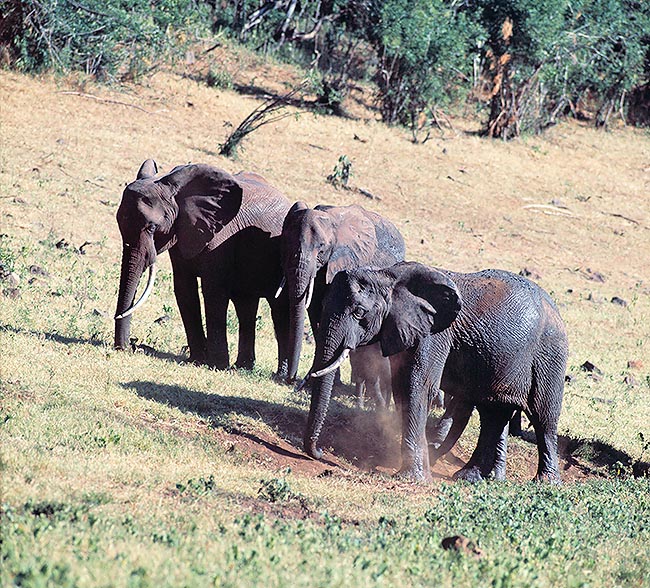
The Loxodonta africana cyclotis is smaller, darker, with thin tusks parallel to the trunk © Giuseppe Mazza
Just as an example, the molars of the mammoths were simple and not repla- ceable and differed from those of the modern elephants.
We recognize nowadays principally two subspecies or races of the African elephant (Loxodonta africana Cuvier, 1825) : the African Savannah elephant (Loxodonta africana africana) and the African Forest elephant (Loxodonta africana cyclotis).
The two subspecies may have, in some countries an over posed habitat, for instance in the most north-eastern part of Congo, but the forest elephant is confined in a less vast area, corres- ponding, in good part, to the rainforest.
The savannah elephant has a bigger size, with a weight which may reach the 6 tons in the males, but, exceptionally, even 7000 kg (average 5000 kg), and height at the shoulder of 330-360 cm, with a registered record of 4 metres, whilst the forest subspecies is significantly smaller, so much that Noack, in the early twentieth century, talked also of an imaginary dwarf elephant, called Elephas africanus pumilio, which, however seems not to exist.
The known specimen was living in a zoological garden and which, at the moment of the christening, was measuring a metre and a half at the shoulder. It is a shame that at the time of its death, occurred during the First World War, the height had reached about the 205 cm, range matching with that of the Loxodonta africana cyclotis, which raises serious doubts about that classification. Loxodonta africana cyclotis has an average height of 240 cm in the males and little more than two metres in the females, with (rare) records of three metres and obviously weights much inferior. Ansell, in the seventies, distinguished some subspecies for both cited species and precisely: Loxodonta africana africana (south of the Zaire of that time, Angola, Zambia and Mozambique), Loxodonta africana krockenhaueri (Kenya, Tanzania, southern Somalia and Uganda), Loxodonta africana orleansi (Somalia and Ethiopia), and Loxodonta africana oxyotis (Sudan and Ethiopia) and, for what the forest elephant was concerned, Loxodonta africana cyclotis (western Africa and Congo River Basin) and Loxodonta africana farahonensis, a North African subspecies which extinguished in historical times. However, as often it happens, it is possible that such subdivision was more theoretical than actual, as is the case, on the other hand, for other animals.
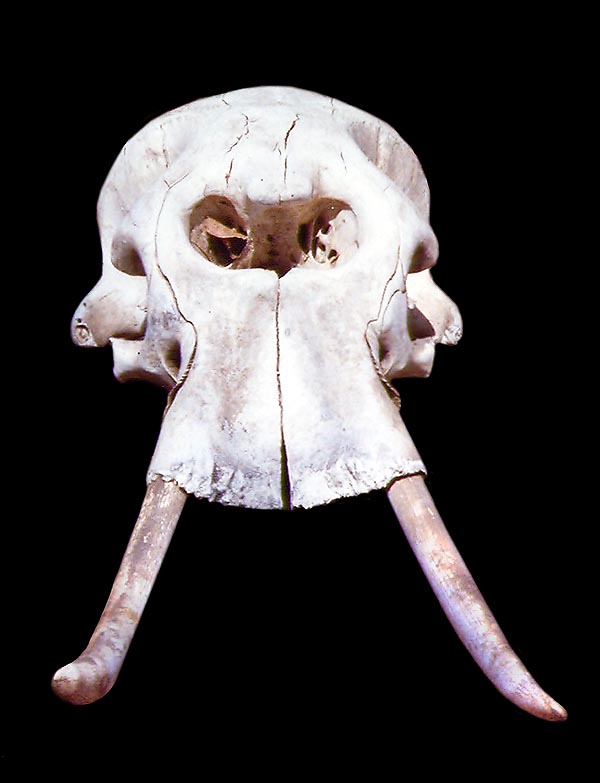
A skull of elephant may suggest the existence of the mythical cyclops © Gianni Olivo
Actually, the real differences do exist and are marked mainly between the savannah and the forest species.
The savannah elephant, apart the bigger size, has wide and triangular ears and more massive tusks, curved and bound, before downward and then forward, in the forest one they are thinner, less curved and are pointing more vertically towards the ground and the ears, as the scientific name states, are rounded.
Both species have five toes, vertically placed, like columns, and sunken into the thick tissue of the foot, but, whilst the savannah elephant has, usually, four visible nails in the fore foot and three in the back one, the forest elephant has respectively 5 and 4.
However, such difference might be due to environmental reasons: the savannah elephant lives and walks on harder soils, often stony, whilst the forest one lives on grounds much softer and this would explain also certain variability and several exceptions (at least for what the Loxodonta africana africana is concerned).
The forest elephant has a smoother and dark grey skin if compared to that of its country cousin, which has, on the contrary, rough skin, with scarce hairs which are thicker in the immature individuals. The adults have developed eyelids (a protection against dust and insects), and hairs at the level of the outer auditory meatus. At the level of skeleton, some differences are evident between the two subspecies, essentially in the jaw, which has a different conformation, with mandibular condyles which are oval in Loxodonta africana cyclotis and spherical in Loxodonta africana africana.
The skull of the elephant has a seemingly strange and alien appearance to those observing it for the first time; the orbits are not defined as in other living beings, on the other hand, frontally, there is a big cavity, looking like an orbit, but which in reality is the access to the nasal cavities (trunk) and this look led me to imagine, many years ago, when I saw one of them for the first time, that such look might have alimented the legend of the Cyclops.
Let us think to an ancient farmer, who, while spading, has found the remains of an ancestor of our elephants, possibly in a field of Magna Graecia; what could he think?
A giant with one only eye and with two protruding downward tusks: it is quite a short step to imagine a monster hungry of human flesh.
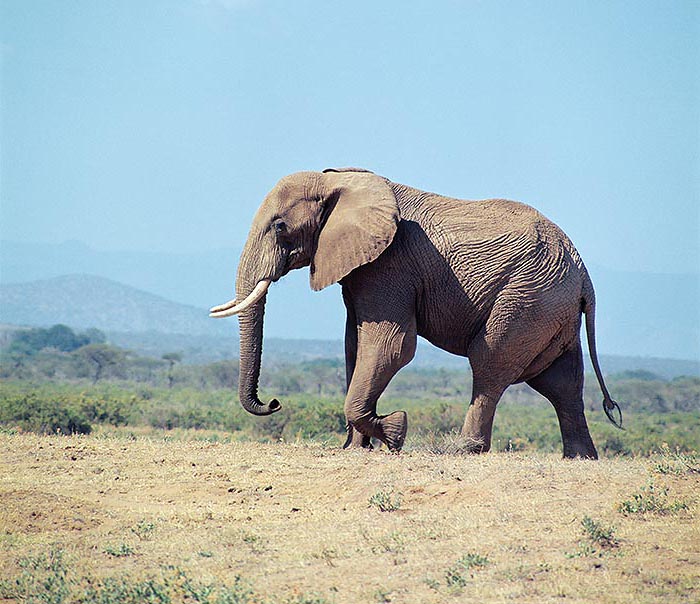
The prints drawing differs in each elephant and often allows to follow its traces © Giuseppe Mazza
The feet of the elephant have a thick cartilaginous pad which allows, among other things, to move silently, when necessary, and the “sole” has a reticulum of fissures resulting clearly in the trace.
The drawing of the plantar fissures forms, in conclusion, a sort of “digital fingerprint” through which is possible to recognize and follow a certain specimen even if it is subject, in the time, to changes even macroscopic, whereby the print characteristic of an elephant may remain unchanged for a more or less long period of time, but rarely for ever.
The trunk is the characteristic which, more than any other, distinguishes these animals and forms a multifunctional organ: nose, suction pumps, ejecting pump, extremely sensitive accessory finger provided with incredible
Delicacy of movements and agility, arm with a power similar to that of a crane, snorkel to be utilized in water, devastating weapon like a hammer, but also capable to gently remove the residues of foetal membrane from the newborn and to help the young. The ears, besides being sounds sensors, are covered in long and wide by blood vessels and the continuous movement acts as thermo regulator and as disperser of the exceeding heat, besides as fly swatter; furthermore, they contribute to the complicate body language of these animals.
The tusks, more curved and more forward directed in the savannah species and straighter and downwards directed in the forest one, are in reality superior incisors particularly developed in function of weapon and tool and usually present in both sexes, even if the males’ ones are more massive and developed.
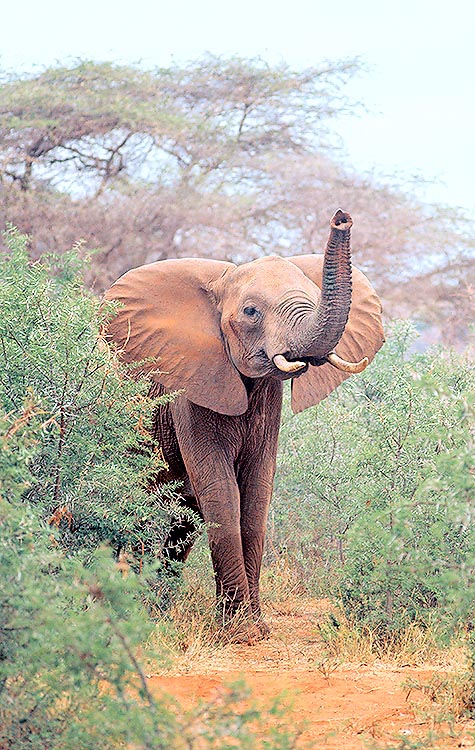
All purpose trunk. Nose, pump, finger, arm and snorkel when swimming © G. Mazza
The sizes of the tusks do not proceed hand in hand with the mass of the carrier, so we can find rather small big tuskers and enormous individuals with 30 or 40 pounds tusks.
The maximum recorded weights are over the 100 kg per tusk but it was matter, even if in old times, of exceptions that shaped the history. 70 lbs tusks are considered as remarkable and at times specimens are met that fall within the category of the legendary “One hundred pounders”, however the average is of 50 lbs per tusk. The length may vary also independently from the weight, so I have seen 250 cm tusks weighing 30 kg because thin, and tusks (especially in great savannah elephants), short but with a huge diameter, weighing 80 pounds (almost 40kg). The longest extant conserved tusk reaches the three metres and a half.
The genitalia are placed between the hind legs and in the female the vagina opening faces downwards, they are, therefore, in different position than that of many other animals and are placed among skin folds. The male holds internal testicles and the copulatory organ is curved backwards, but when erected, in which case it gets enormous dimensions, also in function of the position of the vagina of the female.
In the female, the udders are placed much more forward than the bovids, and are two, placed between the fore legs, in a position somewhat reminding that of the human species.
The only odorous glands are the temporal ones; also these ones are oversized and may weigh 3 kilos in the male and one in the female.
Their longevity is substantial, obeying to that non-written rule stating that, generally and with the due exceptions, bigger sized animals tend to live longer, however, despite many legends, the average stands on the 60 years, and even if we cannot exclude that some Methuselah of the species may reach the 80.
For what the senses are concerned, hearing and smell are excellent and the smell, in particular, is an effective tool for localizing not only food and water, but also possible dangers. It is not rare to see trunks emerging, like enormous snakes, from an extent of tall reeds: the odorous particles, perceived by the trunk, are then placed in contact with the olfactory receptors and furnish precise information to the pachyderm about the location, direction and distance of their source.
Distribution
The elephant is present in the sub-Saharan Africa with a leopard spots distribution. While looking at the map of Africa, we may imagine a great central spot, uninterrupted, which corresponds to the central African rainforest and which houses the Loxodonta africana cyclotis, a second great spot, transversally placed, going from the Atlantic, following the boundary Angola-Namibia-Botswana, to the western limit of Zimbabwe, where it parts, bordering such country north and south and following the course of the river Zambezi to the north and the Limpopo to the south, and then a crowd of spots of various sizes which constellate the various African countries.
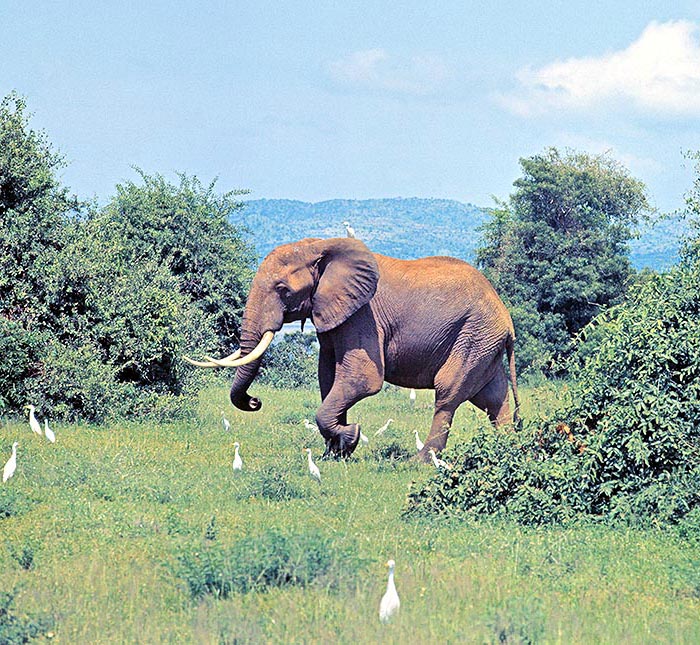
Broad or thin, the tusks vary with the animal size and may reach the 3 m and weigh 100 kg © Giuseppe Mazza
Absent from most of desert Namibia, but the areas of savannah rich of water (Okavango, Etosha and Caprivi), is however present, in a limited population, also in the northern part of the desert of the Skeleton Coast, populations which has adapted to live in a very arid zone.
These elephants often apparently slim and with the legs which seem to be longer, cannot, in reality, do without water, but rather, have specialized in covering long distances looking for the same.
The rainforests of western Africa have smaller spots of presence, even if they are dense, whilst other zones of big size are placed in the Central African Republic, the zone of the great lakes, part of Tanzania and Mozambique.
In South Africa, the elephant is absent in good part of the territory, but is numerous in the north (Limpopo and Kruger zone and neighbourhoods) and in a small enclave in the south (Elephant Addo National Park).
Social organization
A quite complicated sociality unites in groups, females, young up to the 12 or 15 years of age, whilst the adult males tend to form groups of bachelors or to stay by themselves. Often an old male is accompanied by one or more younger males, often colourfully called “askari”.
The typical group unites related females, usually a matriarch with its last calves and the daughters now adult which have, in turn, generated and, possibly, the nieces, and often counts a number of heads varying from the few units to 30. The most common are groups of a ten of individuals.
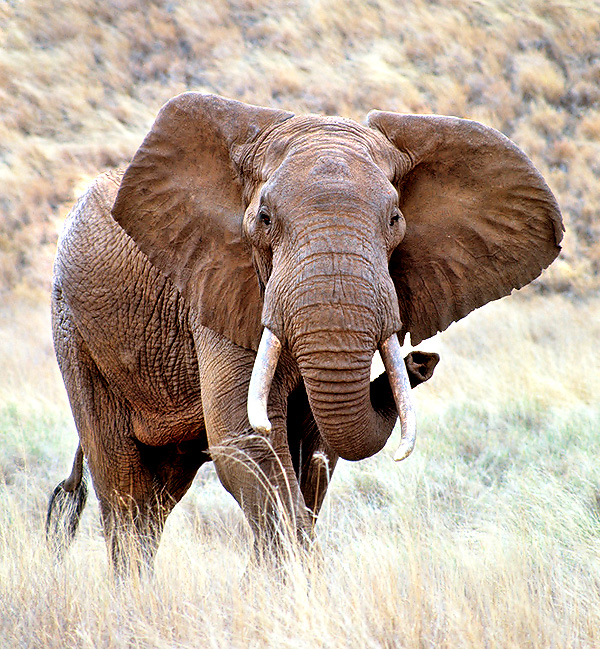
It’s not easy to predict an elephant reactions. Many experts have passed away © Giuseppe Mazza
The fact remains that there are, in some areas, associations of more clans, with tens and, at times, hundreds of individuals which seem to belong to the same family.
The matriarch represents the apex of the hierarchical pyramid and it’s this one that the clan relies and follows.
When it stops for grazing, the groups disperses (but with each member always remaining in hearing contact, as we shall see later on when talking about the sound signals), when it starts again, the group consolidates again and follows.
Usually, the matriarch comes before and an adult female acts as a rearguard: if a danger is suspected, the clan groups around the female leader and all components cooperate in the possible defence.
This makes us understand the greater dangerousness of a group of females compared with a male, even if aggressive: frequent are the mortal incidents due simply of having wrongly transited close to a group whose presence had not been noticed.
In such case, the charge is often acted by several individuals and even if we are equipped with defensive weapons, often the conclusion is tragic.
As for the man, and unlike to what occurs in many species of animals, the social life of a matriarch in its menopause, may continue for long timing keeping intact its leadership, at least till when the age does not render it so weak not to be able any more to perform its functions. When this moment comes, the old queen gets away from the group or is abandoned and the following older and more experienced female takes its place. When a clan becomes too crowded, it tends to part in two groups which anyway keep in contact and in almost familiar relationships.
The association with not related groups may happen but it is never so much close and not even so much tying and two unrelated groups may, yes, proceed or graze together, but this rarely goes beyond a pacific coexistence and also the so-called elephants rituals are never performed towards an unrelated clan. The relations between males follow different lines.
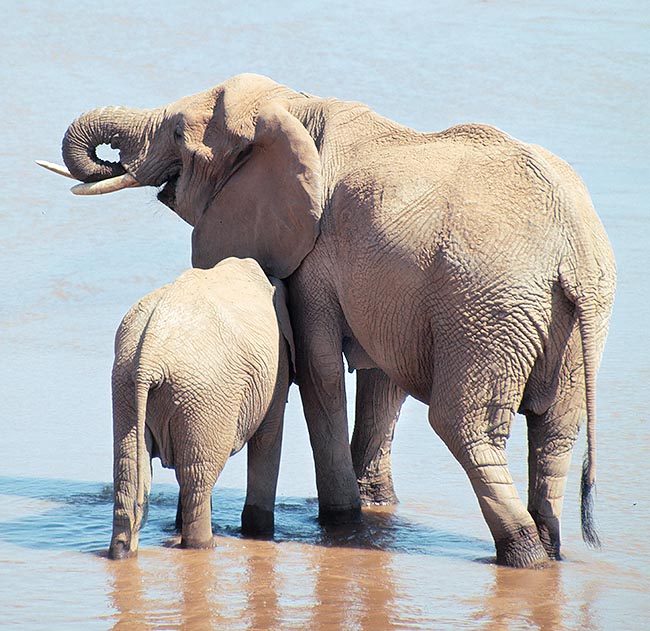
The breasts are between the fore legs, in a human-like position © Giuseppe Mazza
The males leave the clan between the 12 and the 15 years, rarely later, but the separation takes place gradually, in the sense that the young, by that age, almost begins to claim its autonomy, remaining in the orbit of the herd, following it, even if at a distance.
It is an orbit which gets widening till the separation, almost due to prevalence of the centrifugal force on the centripetal done by the family group and, from that moment, the young enters the adult age and is, in fact, the puberty arrival is one of the springs generating the separation which, to say the truth, is often encouraged by the females, increasingly intolerant of the young growing sexual itches.
The associations of 2-10 bachelors are the most frequent, but groups up to 140 males have been reported and in at least one occasion I saw 50 of them all together.
In another occasion, I and a friend, while coming back to the camp at the sunset, on an open Toyota without doors, suddenly we found ourselves in a, to say the least, alarming situation, surrounded by tens of bull elephants.
These groups are used to wander on vaster areas than the females, but often have some areas of choice where they willingly stop and where they go back more or less on a regular basis. When a male goes in musth, it starts looking for a female.
The musth periods are not related to particular seasons and not even synchronized and may last short or long time. In this phase, the male is aggressive and irritable; the temporal glands secrete a lot of a fluid more viscous than usual, which often drains creating typical dark striae visible from far away, and the penis is often partially erect. When a female goes in oestrum, at the beginning it seems to be irritated in response to the attentions of a male, and its behaviour and posture change. It walks the head raised, the eyes, kept much more open than usual, look ahead instead downwards, the ears flap more frequently and, if the male tries to get close, tends to go away.
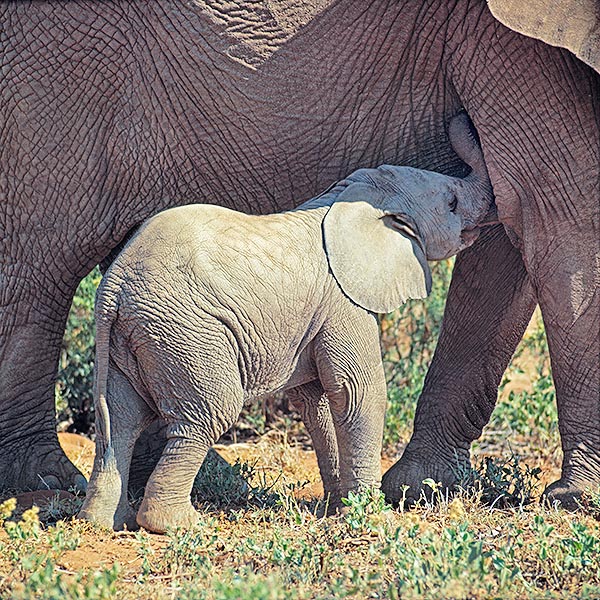
The milk is rich in fat and proteins. The cubs don’t drink it with the trunk, but with the mouth © G. Mazza
This at least initially, then, gradually, the female seems to get used to the idea, and when the moment comes, gets away from the group, often with the tail raised, often looking back, as it wanted to be sure to be followed, and so it may get far, also a lot, from the relatives.
When it stops, or is reached, the male often lays the trunk on the back or on the head of the female and then tries to mount it.
At times the female accepts the avances at once, other times it starts walking again, almost as it wants to be wished, and effects a variant of what is called the courting march.
Indeed, it is not really this, because the true “march” aims to discourage the less endowed males and at this point we need perhaps to do a clarification about the strategies of the various animals for the conservation of the species and for this reason, I take the liberty of an extra-elephantine digression.
In the monogamous species, there is a stable relationship female-male: duikers, foxes, African wild dogs, klipspringers, etc. form a pair and, in the case of gregarious species (African wild dogs, for instance), a leading pair, to which is entrusted the transmission of the best genes for perpetuating the species.
The polygamous species may practice the polygyny, like the hippos, many antelopes and the suidae, with a male having a real and proper harem, or the polyandry, in which case it’s the female who has more husbands, phenomenon more frequent in the birds, or even the polyganandry where is the sexual equality and males and females can mate with different partners (felines, tragelaphus, giraffes, honey-badger, pangolin, etc.). In the non monogamous species, as a leading pair does not exist for ensuring the transmission of the best genes, the reproductive strategy is different, and here are some tricks utilized by the nature.
For instance, in the case of the lions, there are retarding mechanisms allowing the transmission of the “best” characters, through what is called induced ovulation, which prevents, in practice, the young or the weakest to fecundate. This explains also the frenetic and repeated couplings of the lions, because the ovulation, in the female in oestrum, does not happen automatically, but it must be stimulated and triggered by repeated sexual acts, whereby a lioness at times, will mate even hundred times before being fecundated.
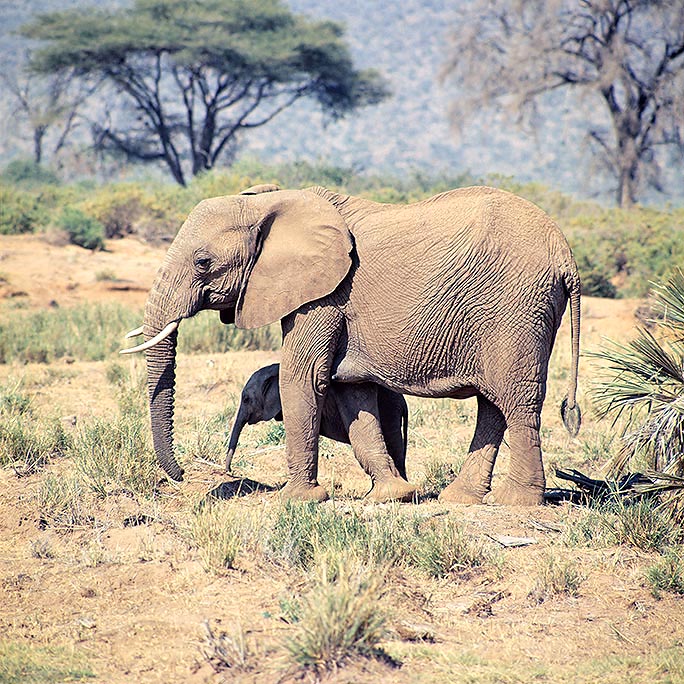
A cub at the mother shade. The elephant society is matriarchal © Giuseppe Mazza
This renders unlikely for an inexperienced young to keep away an adult and endowed male and even if it will be able to get a quickie, it will be very much difficult that it will be the father of the lady’s cubs.
In animals where the ovulation happens spontaneously, the female uses other tricks for procreating with the strongest specimen and tends to “sell high the skin or the virginity”, and this is the case of our elephant, for which I get back to the point.
The courting march is to discourage and elude the attentions of the young which would like to push themselves forward (or better, over)and it is a marathon of short runs and zigzagging marches in the bush, at time with aggressive attacks against the parrot on duty.
By sure, during the time the female requires for getting used to the presence of excited males, a serious pretender will have come, with a nice (genetic) patrimony which may guarantee a future to the cubs that will be born. And in this way, the nature has solved another problem.
In the moment when the receptive female accepts the avances, the male mounts it and the masculine organ which at this moment is a tool of almost 30 kg, can reach, curving forward, the vagina, placed, as we have seen rather ahead, and the mating takes surprisingly little, as an average, less than one minute, accompanied by rumbles similar to borborygmi and at times by shrieks, unexpected in giants of such a mole. Usually, the female has its first delivery when 12 and usually it’s matter of one cub only (the twin births are rare), after a gestation of 22 months. It is rare that a second pregnancy happens before 4 of 5 years.
Unusual communications sounds. Borborygmi and farts.
The African elephants are animals which vocalize and willingly communicate utilizing a great variety of signals, often much different. Being highly “social” animals, with a complicate and variegate organization, the variety of sounds utilized is surprising. When walking in the bush, usually we proceed silently, in order to get close to some wild animal, and this may present also big risks because it is easy to enter, without realizing this, the attack perimeter of some dangerous animal.
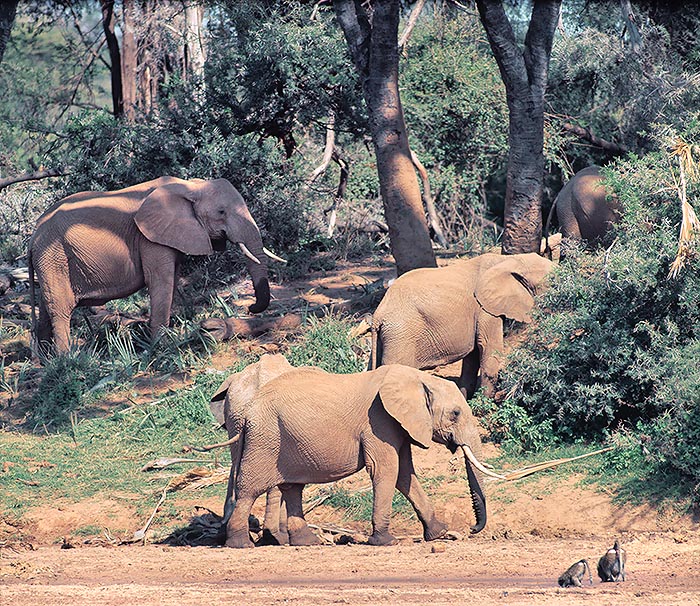
Various gurgles, like borborygmi of troubled bowel, often reveal their presence © Giuseppe Mazza
Almost all wild animals have, around them, virtual perimeters which may be quite variable depending on the species, the environment and thousands of other factors.
The outer one is called attention perimeter, which means that the animal will keep alert, controlling the intruder, but will not run away. More inside, stands the escape perimeter, the distance within which the animal will go away, if the alleged danger has crossed it. But, when closer, there can be the perimeter of charge or aggression, that area where the animal, feeling trapped, may react with an attack, at least if it is matter a wild animal equipped with weapons (horns, fangs, claws, weight).
As I said, the elephant willingly communicates with sounds, but it may also be silent and the sudden getting at twenty metres from one or more proboscideans, is not safe at all.
For this reason, when in the bush a great attention to the sounds is to be paid. And to know them.
One of the most typical signals revealing the proximity of elephants are the gurgling of various kinds and intensity which seem to be the borborygmi of a disturbed bowel and which may be invaluable for avoiding to get in trouble. A sort of a blast of trumpet may indicate nervousness and may be the harbinger of a charge.
It is true that often the charges accompanied by trumpeting, wide open ears and excessive noise are at times mock charges, intended to scare the intruder, whilst usually a lethal charge may be carried on silently, the ears flattened on the shoulders and the trunk rolling up on the thorax or protruding; however, any demonstrative charge may turn, at the last minute, in a destructive (literally) attack, especially then if the intruder runs away. Besides the sound signals, also some postures and “gestures” of the elephants must be known by those entering the bush, for their own safety.
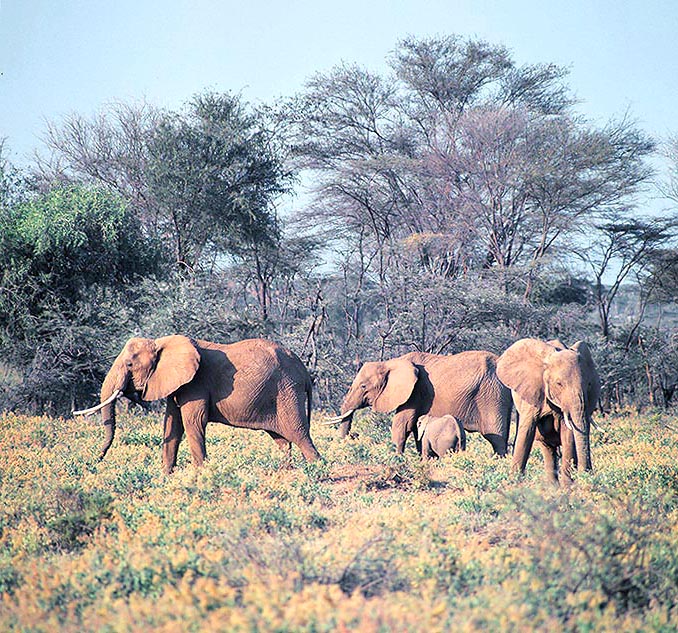
Farts and bowel sounds, often not audible to our ears, belong to their language © Giuseppe Mazza
An elephant raising the fore foot and oscillating it like a seesaw may signal an impending charge, whilst the fluttering of the ears forward and then beating them as if they were carpets, may indicate nervousness or indecision, but, some time, it is a normal occurrence.
However, if such movements of the huge ears are accompanied by a raising the head with extended trunk, this is almost surely a sign of great excitement and alarm: Indlowu has suspected an unwelcome presence and so it may charge or go away.
Also the tail is a warning bell and if raised, this might mean irritation or anxiety.
An unrolling and rolling trunk like a hesitant python, often shows that the animal has not yet decided whether to attack or run away, as the rubbing the eye or the head with the extremity of the trunk.
At times, a clearly nervous elephant catches and breaks branches, throws them against the ground or a plant or against the disturbance source, and also this means that it does not yet know what to do, but in any case these are signals to be kept in due consideration.
Going back to the borborygmi, a rumbling crescendo finally transforming in a bellow or a roar, often precedes an attack. No matter how much experience you may have regarding elephants, the reality is that there is no expert capable to foresee what an excited elephant will decide to do, and we have to keep well in mind that many experts have passed away just for a small, simple evaluation error. But the repertoire of elephantine voices does not express only bellicose intentions: the community, adults and young, keep in touch communicating through a variety of sounds. The known “rumble rumble” are not always and only bowel sounds or belches.
When, many years ago, I started my “African way”, I began to wonder about these borborygmi: was it possible that great and perfect animals as the elephants are, may suffer constantly from aerophagy?
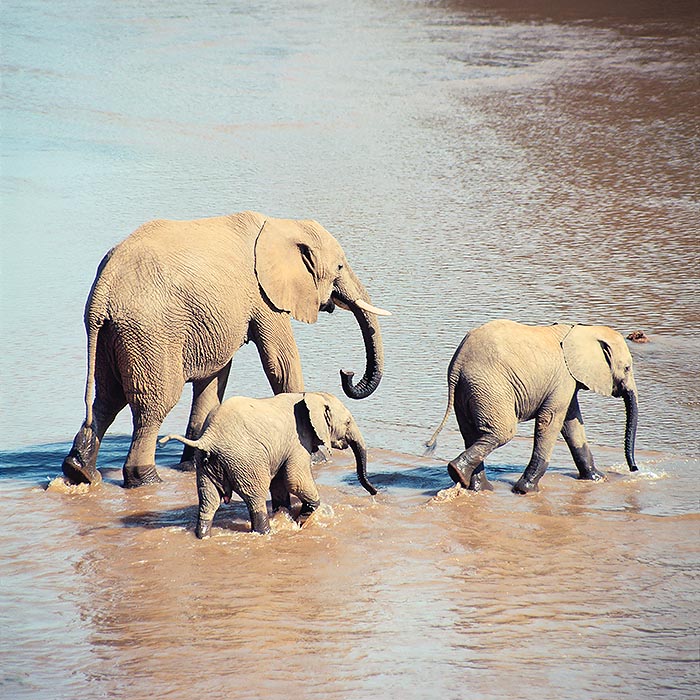
Elephants can’t do without water and often travel a lot to find it © Giuseppe Mazza
Is it possible that organisms made for transforming tons of vegetables into overwhelming energy might be suffering from chronic tympanites?
I got the doubt that these “farts” might be, in reality, something else and I got the confirmation, during the following years, both from personal experience and from following the interesting researches done by scholars about the matter.
These grumblings, which vary from frequencies the human ear does not perceive to the well known noises we are referring to, are often signals tending to keep the contacts between individuals, at times kilometres far away (as it happens for the cetaceans), but until now there is no dictionary capable to translate all the nuances of that ventriloquistic language.
The sounds we can catch are usually emitted during the “grazing” and express, possibly, satisfaction and contentment, or are signals of aggressiveness or alarm, but often one member of the group, often a female, emits a more powerful contact Grunt with the matriarch or other elephants.
Additional considerations
I would like, finally, to tap a subject in order to dispel some clichés I often hear, even if such matter may not be appreciated by somebody, but if we try to understand and know a complex reality like that of the cohabitation man-animal and of the survival itself of the wild fauna in a world where the human population is reaching astronomical figures in terms of numbers, well, stereotypes, utopias and Disney visions of the nature are to be set apart, as it is necessary to clarify some categorical and incorrect assertions. The elephant is a splendid animal, which deserved to be protected, but this does not mean that it is not also to be controlled. First of all, in many African areas, the “rogues”, alias “problem elephants” are a reality to be reckoned and in these cases feel-good solutions do not exist, whatever we may think about.
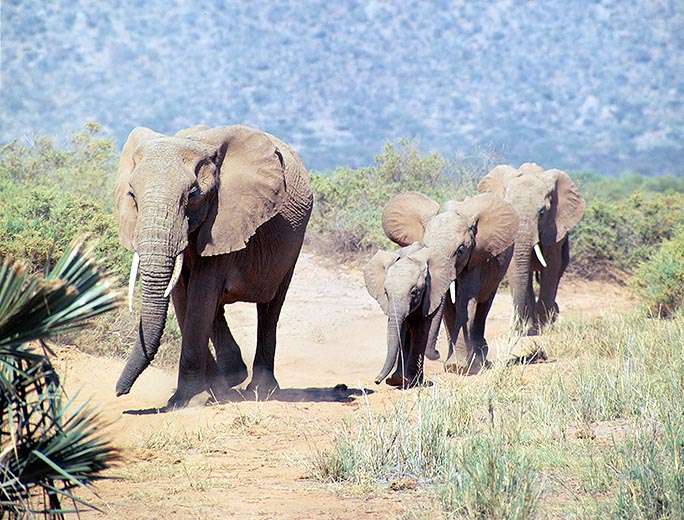
The herds keep always moving and this is often a problem in the reports with man © Giuseppe Mazza
To protect the survival of the various species is, obviously, a duty, and if a species is endangered, we have to realize efficient protective safeguards, however, very often we utilize partial and catastrophic assertions such as: “The elephants are disappearing”, or: “The leopard is a feline close to the extinction”.
With all due respect to some Cassandras, these wild animals are not rare and not even about to disappear from the face of the earth, particularly, for what the elephants are concerned, in some African countries the problem stands in their numeric excess, with serious risks of desertification of vast areas and of disappearance of many other animal and vegetal species.
The Washington Convention totally protects some species (for instance, the tiger and the black rhino) really considered as endangered, whilst other species are only partially protected, and the collection of such animals is carefully regulated and monitored, but foreseen.
The white rhino, the leopard, the elephant are all protected in regards to the trade of these animals or of parts of them, but, contrary to some erroneous and misleading allegations, often appearing also on the mass medias, they are species which may be hunted legally, at least in particular countries and in a number fixed each year by the international experts, subject to the issuance of the relevant CITES permission, with the prohibition for the owner of the tusks or the skin of the animal, to trade them or even only to give them to any third party, and this is, itself, the proof that the health status of such species is not seriously endangered. Furthermore, a prudent collection has other benefits, such as the numerical control which, in this instance, associates with an economical benefit that may be exploited for the “conservancy” itself, whilst the meat may nourish entire villages. For this reason, moreover, in some properly managed national and private parks, it becomes necessary to practice the culling, that is the selection killing.
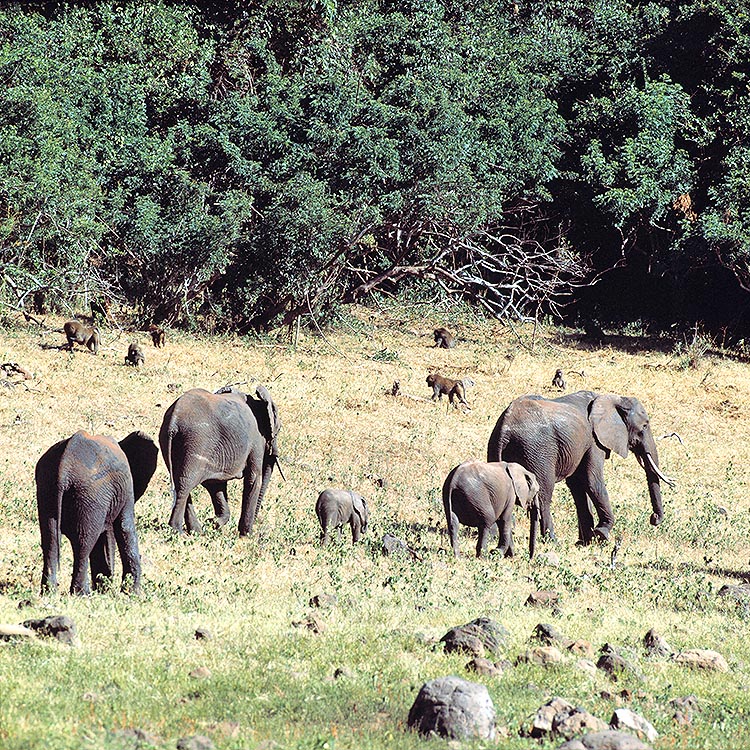
A herd of Loxodonta africana cyclotis with baboons. In narrow reserves the forest is compromised © Giuseppe Mazza
There are African countries where the surplus of elephants takes dramatic proportions and this leads to make some considerations: the aversion of many for the culling (the programmed killing of specimens in surplus) exercises pressure in favour of the practice of anesthetizing and shifting the exceeding specimens.
From a practical point of view, this solution has risks and incredible costs and it may be justified if we intend to repopulate a zone where the elephant has disappeared, but it is a solution which may done within certain limits and with full attention, avoiding, for instance, to transfer unexpectedly young animals, separating them from the herd, thus risking to create aggressive and dangerous “bandits”, and all this with enormous costs.
The culling is a practice recognized as necessary by many experts, for the conservation itself of the habitat and of the species, and less cruel than some forced relocations, resulting in capture stress and various other drawbacks. A male elephant can bring down about one thousand trees per year and this not only for getting food, but also for checking its own strength, or even only for fun. An adult male is capable to eradicate a plant with a diameter of one metre, if the soil is not too hard, and to break trunks with remarkable diameter, and if we look at the desertification done by these bulldozers, we realize that some doing good is dangerous primarily for the elephants (considered as a species in toto and not as single specimen), as well as for many other animals.
Each plant broken down (imagine if this should be done by the man) means hundreds or thousands of insects, reptiles, bats, batrachians, which remain deprived of food and shelter. Not forgetting other consequences such as the soil erosion phenomena.
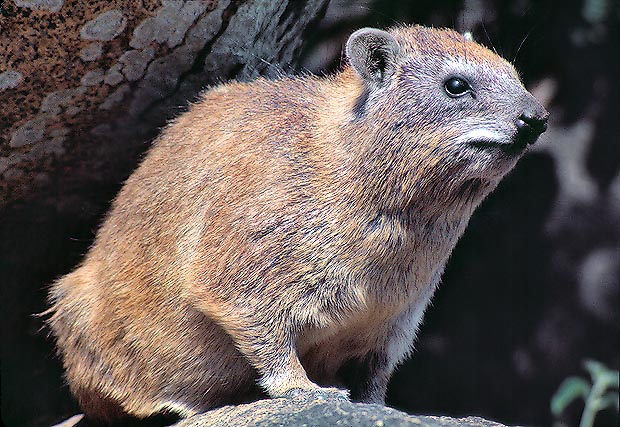
The Proclavia capensis and the elephant are relatives having a common ancestor © Giuseppe Mazza
I have appreciated the balanced review of the problem made by an African scholar, and as balanced I mean that it is not done by a hunter, who might be accused of bias, and not even by an “ecologist” (I beg pardon for the quotation marks, but after me there is a huge difference between a scholar who deals with ecology in a dispassionate and scientific way, and persons who define themselves as ecologists by conviction or vocation), who equally and surely will be so.
In this close examination of the problem, this scholar who, inter alia, lives in Africa, emphasizes that we have to worry to protect the species and the single animal, and that it is necessary to give priority to the exigencies to those living in Africa before pleasing those who, even if living far away from the African reality, would pretend to teach what is just or wrong to do in a context they know only through some documentary films.
Indeed the word “conservation” does not consist in pleasing a utopian, idyllic and simplistic vision of the fauna, but instead to preserve it taking advantage of the same and not placing it in a showcase. Transferring, as it were bags, thousands of elephants, as somebody hopes as alternative to the culling, has many and many problems (and often more misery) than the culling itself, besides the danger to the populations and the tourists, as often animals taken off from their range or the group become more aggressive and dangerous towards the man and other animals. Furthermore, ignoring the stratospheric costs, not all nations are keen to take new elephants and paying, moreover. The birth control, then “bloodless” remedy to the culling, is finally, as I may see it (and I am not the only one), an even more dangerous interference.
Common names. Afrikaans : Oliphant; isiZulu, Xhosa, Siswati: Indhlovu, Indlowu; Sotho: Thlou; Venda: Ndou; Shangaan: Ndlopfu, Indlofu; Lozi: Tou; Mbukushu and Yei (delta Okavango): Unjovo; Tswana: Tlou; Swahili: Tembo.
→ For general information about PROBOSCIDEA please click here
